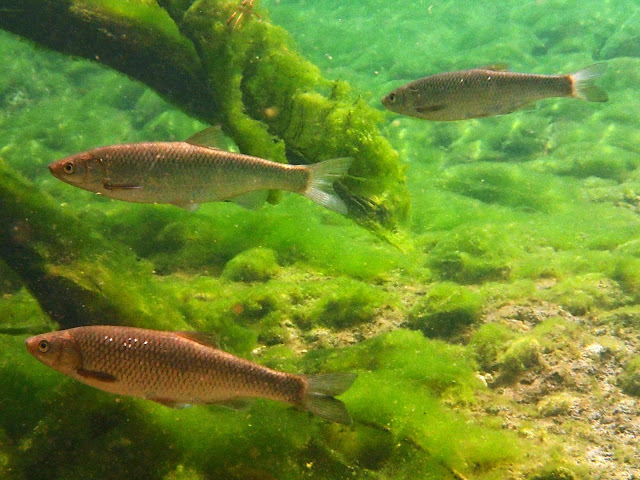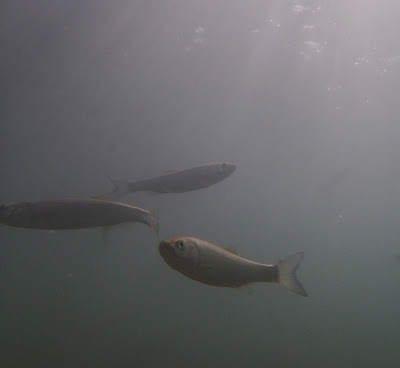Like a "Pollack painting" a mass fish kill above the sluice at Oroklini Lake, Cyprus (Photo by Melpo Apostolidou / BirdLife Cyprus in late August)
September 7th 2013
Fish-kills are often the first signs of stress in an inland water body. Most times these are not naturally occurring events, especially when an endangered species is concerned: In this case Eels on Cyprus!
The European Eel (
Anguilla anguilla) is scarce and critically threatened on Cyprus. It has declined dramatically on the island. IUCN lists the European Eel as "Critical" (i.e.
critically endangered, the highest category of threatenedness). So when naturalists found a very large number of dead and dying eels at Lake Oroklini near Larnaka they were at once shocked and confused. What and why???
A few weekends ago, I flew over to Larnaka and was shown the dead eels. My friends were on hand to help with counting the eels and studying the problem (**see footnote). I am making some "results" public pre-maturely because many people have asked me about this problem. We are gathering data and analyzing all we collected to research the problem. So results and interpretations are still "preliminary".
Results
1. We found groups of dead eels at five locations at Oroklini Lake. The total number of dead Eels that we saw was estimated at no less than
1200 individuals. But the fish-kill could realistically be double or tripple this number. But, to be conservative, we will record this Fish Kill at 1200.
2. At one point more than 450 eels had died in a dessicated channel since they were forced by a low concrete sluice and these were easily counted since they were concentrated in an area of only 65 square meters (see photos).
3. We manually measured the total length (TL) of a sub-sample of 200 Eels at the sluice in order to check the age-class structure of the doomed fishes. The sizes ranged from 17.7 cm (the smallest) to 59.1 cm. The overwhelming majority of the eels was 28 to 40 cm approximately.
4. Generally at other locations where we saw and photographed dead eels, most individuals were under 45 cm. Isolated individuals exceeding 60 cm were seen, but these larger fish were extremely scarce. So, the cohort of larger female Eels -which need more than 10 years to mature in inland waters- was probably not in our obseverd records here. (Hopefully, some larger specimens have survived upstream somewhere..).
5. A lot of the "stranded" or dead fish were obviously consumed by predators; I believe this has been taking place as Oroklini's waters begun to shrink at least since April (see photo-trap snapshots). I assume in mid-summer more and more fish crowded in shrinking pools attracting predators. I roughly estimate that the peak of the mass-dying eel concentration episode lasted at least 100 days and this was taking place at various locations in Oroklini - not just the notorious sluice site (at least 3 locations). I estimate predators (birds, foxes) fed on at least 20 eels per day at least during this drying summer period. So at least 2000 eels most probably perished like this also. BirdLife Cyprus provided me with photos of three heron species feeding on Eels like this before the peak dessication begun (in spring). So, the c. 2000 devoured eels is a minimum number and again an obvious underestimate. However, it shows that the numbers of eels that Lake Oroklini sustains is higher than anyone could imagine for a Cyprus wetland!
 |
Night photos taken by a photo-trap at the North-west end of Oroklini (at the Sluice). Six photos show birds feeding on eels in mid spring, between 29/4 – 15/5 2013. Some photos show birds feeding on eels at a high frequency (2 minutes between feeding). Three birds were identified as predators (this is a Night-Heron). Photo provided by BirdLife Cyprus.
|
.JPG) |
| Night photos taken by a photo-trap showing Grey Heron feeding on Eel. The other species also feeding was probably a Purple Heron. Photo provided by BirdLife Cyprus. |
Why a a mass death of eels?
These are the following reasons we believe eels died like this here:
1. Simply they could not find adequate aquatic refugia since the artificially fragmented waters (the slucies, plugged culverts, canals) dried-up and the fish died. Fish simply died since the waters dried-out completely and they could not move away - although water does exist in a fairly large area even during late Summer at Oroklini.
2. Where the fish did find deeper permenant waters, the water became polluted, highly eutrophic and with very low oxygen and very high salinities. The fish could not stand this stress and slowly died. (Here we found many eels in various stages of decomposition, so they did not all die at once). We also found two large grey-mullets (Mugilidae sp.) that had died in these canals (and the bones of at least one grey-mullet with the 450 eels above the dried-out sluice). The populations of Mosquito fish were also lower in these high-saline canals, but we found no dead mosquitofish. The canal with the most dead eels had stagnant near-hypoxic conditions with very little life (even an absence of preceptable insect life). Most of the dead eels seen in water where at this stagnant disconnected cannal.
Have I ever seen such Eel-death 'carnage' before?
Not in Cyprus. Yes, in Greece: at Schnias Marathon National Park (near Athens) in 2010. Similarly a problem with a badly placed sluice.The 2010 fish kill at Schnias probably involved 2000 Eels! I recently mentioned this problem in blog post since we found "entrapped" eels here again (
http://zogaris.blogspot.gr/2013/08/schinias-national-park-ichthyo-tragedy.html).
Why is this mass death event so important for Cyprus ichthyology?
1. We know very little about eels on Cyprus; some people think they are nearly extinct there (although many people know that in the past they were widespread on the island). The eel is an important indicator of river basin integrity- it needs un-impeded access to the sea, wet refugia during dry-hard times, reasonable-quality waters and food (a functioning rich food-web since Eels are carnivores). So since Cyprus's rivers and wetlands have been anthropogenically "trashed" - Eels are thought to be extinct by most people! (We did a questionnaire about this a couple of year back...).
2. Cyprus' society doesn't really seem to care about Eels. So nobody really wants to research them. (Perhaps because it is dirty work - muddy diffiult waters - can't electrofish in high-conductivity water; eels are slimy etc etc.- I suppose....).
3. It should be said that the Oroklini event is definately the LARGEST ever recorded fish-kill of eels on Cyprus. Eels are extremely scarce and cryptic on Cyprus - and many people think they are totally absent or extinct - so this is a surprise!. Our recent HCMR-ISA project funded by the Water Development Department located eels in only 14 places among 170 surveyed sites on the island! Eel deaths (less than 10 individuals...) have been recorded at the Ezousa River and at the Diarizos River Mouth in the last 5 years. More on this will be published in an upcoming scientific paper.
This "find" of so many Eels shows that
contrary to past research and public opinion fairly large numbers of eels enter Cyprus's inland waters. Obviously they don't survive well here. And humans are responsible.
How can we protect Eels and their inland water fish-communities on Cyprus?
1. Manage and restore habitats for Eels; and I mean intentionally with a scientific strategy and detailed conservation plannign...in order to provide for their migration, staging, movement, survival needs.
2. Prioritize site conservation on selected river basins where we know Eels exist in large numbers: Oroklini, Chrysochou, Ezousa, Diarizos, Pediaios, Chapotami, Germasogeia, Pyrgos. Concentrate actions to protect and enhance habitat for eels there first.
3. Do more conservation-relevant research Eels. Inventory eel habitats and their barriers to migration; get students involved in the study. Study local consevation needs of the eels.
4. Employ eels and fish research in inland water biological assessment; especially when providing measures for restoration.
5. Get the public interested.
Scientists should speak-out first. Scientists have factual specific and constructive things to say about Eels- many people have a poor awareness about eels. Awareness, education, and a general sensitization are critically missing on the subject of native fishes on Cyprus. Eels are migratory fish: at least we could celebrate World Fish Migration Day (24th May...).
The Eel could become a
conservation icon in Cyprus - an eastern-most survival outpost for this threatened migratory fish.
**I thank BirdLife Cyprus and the following friends who assisted with fish-work in the usual dirty-slimy-hot conditions: BIG Thanks to:Iakovos Tzortziis (aka Jacob), Melpo Apostolidou, Athina Papatheodoulou, and Elli Tzirkali. For more information about Oroklini please see BirdLife Cyprus at
http://www.birdlifecyprus.org/en/html-27-LIFE_Oroklini.html and the project site:
http://www.orokliniproject.org
Photos from three visits for survey and sampling in early September 2013 follow.
 |
| The "notorious" Sluice. Above this low concrete sluice is the major upland basin of Oroklini Lake. Hundreds of stranded Eels died here since the entire upland basin dries out in Summer. |
 |
| Athina Papatheodoulou with 450 eels immediately above the Sluice. My Zeiss binoculars are on the ground for scale (Left). |
 |
| North-South Canal. Terribly close to new subdivision buildings and hydrologically isolated. Some living eels were still in this 525 m long isolated water body. |
 |
| Dozens of decomposing Eels of the surface of "South Canal" immediately West of the North-South Canal. This canal turned pink and was probably nearly anoxic! |
 |
| Decomposing Eels and my hand for Scale. These are in the "North" Canal which was a lot less hypoxic. Eels were in various stages of decomposition - so they did not all die at once. A long gradual death means many dead ones are not apparant. Again supporting that my fish kill estimation is probably a gross understatement. |
 |
| Salt flats and totally salted-over remnant pools in the Oroklini Basin. Salina like flats are natural in parts of coastal lagoon depressions so this is not a problem (and it keeps the Phragmites low and mudflats extensive...). But, did the Eels escape this sudden salt-dessication? |
 |
| Salted-over remnant pool in the main lagoon's basin. Under the encrusted salt its still wet and muddy. |
 |
| Total contrast 300 meters upstream of the "Salted Basin"...A small creek enters Oroklini Lake from below the Larnaka-Agia Napa Highway. Waters are slightly brakish and Phragmites reeds are robust and thick. |
 |
| Jacob in his '70s look volunteering to do all the chemical water samplings. |
 |
| Jacob and I collecting parameters at each and every water body of the wetland (North-South Canal). |
 |
| East Canal near the Beach. Next to the "Galazio Kyma" shoreline cafe. Slightly brakish water and Mosquitofish survived in this tiny refuge; it is actually an extension of the North-East Canal. |
 |
| A relatively HUGE wetland basin exists immediatly north of the Larnaka-Agia Napa Highway. Two small canals feed Oroklini with "freshwater run-off" from here. Much of the catchment is being build-up fast. |
 |
"West Canal". Immediately west of the lake.

"West Canal". Immediately upstream of the coast road to Larnaka Port. Big Grey-Mullets, Eels and Mosquitofish survive in here even in late summer. Slightly upstream of the palms the concrete canal is totaly dry. |
 |
| "West Canal" upstream of its long concrete section. There is water here!!! And living eels! |
 |
| West Canal upland. |
 |
| West Canald Upland. At some points the water was clear others turbid. We saw one Eel from observing from the bank. Both West Canal and East Canal are very important for allowing eel passage into Oroklini. And both harbour eels during the difficult summer period. |
























.JPG)
































